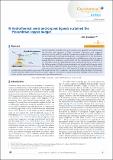Hydrothermal vents and organic ligands sustained the Precambrian copper budget
Abstract
The bioavailability of metals in the early ocean is a key parameter for understanding the evolution and expansion of Earth’s biosphere. Theoretical work suggested extremely low Zn and Cu levels in Precambrian seawater, but these predictions are not supported by recent geochemical data. One explanation for this discrepancy is a strong hydrothermal influx of metals and/or stabilisation in solution by organic ligands. Here new models are constructed to test this hypothesis for the solubility of Cu. The results show that hydrothermal vents constituted the major source of Cu to the Archean ocean, but higher ocean temperatures or higher levels of organic matter may have been needed to stabilise dissolved Cu in seawater. From the Proterozoic onwards, rivers contributed most of the marine Cu budget and concentrations were probably close to the modern range, even if the residence time of Cu in seawater was shorter than today. Biological Cu limitation was thus probably lifted in the Proterozoic, but the origin of Cu toxicity for cyanobacteria likely emerged in the Archean. The results provide a new interpretive framework for geochemical records.
Citation
Stueeken , E E 2020 , ' Hydrothermal vents and organic ligands sustained the Precambrian copper budget ' , Geochemical Perspectives Letters , vol. 16 , pp. 12-16 . https://doi.org/10.7185/geochemlet.2037
Publication
Geochemical Perspectives Letters
Status
Peer reviewed
ISSN
2410-339XType
Journal article
Collections
Items in the St Andrews Research Repository are protected by copyright, with all rights reserved, unless otherwise indicated.

